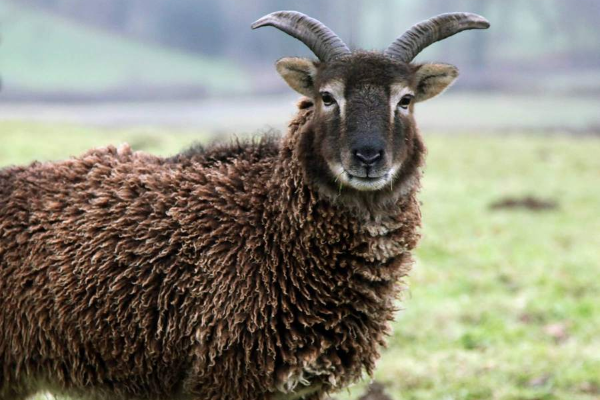The Soay sheep is a breed of domestic sheep (Ovis aries) descended from a population of feral sheep on the 100-hectare (250-acre) island of Soay in the St Kilda Archipelago, about 65 kilometres (40 mi) from the Western Isles of Scotland. It is one of the Northern European short-tailed sheep breeds.
It remains physically similar to the wild ancestors of domestic sheep, the Mediterranean mouflon and the horned urial sheep of Central Asia. It is much smaller than modern domesticated sheep but hardier, and is extraordinarily agile, tending to take refuge amongst the cliffs when frightened. Soays may be solid black or brown, or more often blonde or dark brown with buffish-white underbelly and rump (known as lachdann in Scottish Gaelic, which is cognate to the Manx Loaghtan); a few have white markings on the face.
In the early twentieth century, some Soay sheep were relocated to establish exotic flocks, such as the flock of “Park Soay” at Woburn Abbey, established by the Duke of Bedford in 1910, and selected for “primitive” characteristics. Several Soay sheep were translocated from Soay to another of the St Kilda group, the island of Hirta by the Marquess of Bute in the 1930s after the human population and their sheep were evacuated. The name of the island is from Old Norse Seyðoy, meaning “Island of Sheep”. The breed was introduced to and live wild on Holy Isle off Arran.
Soay sheep were introduced from St. Kilda to Lundy, an island in the Bristol Channel, by Martin Coles Harman soon after he purchased the island in 1925. There is also a small population living wild in and around the Cheddar Gorge in Somerset.
The Soays are particularly hardy and have been allowed to become largely feral. The breed is listed in “Category 4: At Risk” by the Rare Breeds Survival Trust, because there are only between 900 and 1500 registered breeding Soay ewes. The Soay is distinct from two other short-tailed breeds also associated with St. Kilda: the Boreray (from Boreray, another of the islands, and formerly also living on Hirta), and the “St. Kilda”, a former name for the Hebridean sheep (which is probably not from St. Kilda at all).
Breed characteristics
The sheep have short tails and naturally shed their wool, which can be hand-plucked (called rooing) in the spring and early summer. About one kilogram of wool can be obtained from each animal per year. Ewes are polled, scurred or horned and rams are either horned or scurred. They are most commonly brown or tan with a white belly, white rump patch and/or white patch under the chin (referred to as the Mouflon or wild pattern). Occasionally white markings on the face and/or body and legs occur. Rarely self-coloured (solid colour with no markings) black or tan individuals are seen.
This breed has extremely fine fleece and, in contrast to mouflon, the inner fleece is highly developed and it is difficult to distinguish an outer coat. This is a clear indication that the Soay are indeed the product of a domesticated breed in prehistoric times. The breed also lacks the flocking instinct of many breeds. Attempts to work them using sheep dogs result in a scattering of the group.
The lambs are late maturing and produce smaller carcasses relative to commercial breeds. The meat from the Soay is lean, tender and low in cholesterol. It has a stronger flavour with a gamey taste when compared to more common sheep breeds. Crossing with larger breeds, such as the Suffolk or Mule, can produce larger carcasses that will be lean and still retain much of the flavour.
The Soay is very similar to another feral type from the island of Lítla Dímun in the Faroe Islands, which became extinct in the mid-nineteenth century, partially due to overhunting.
